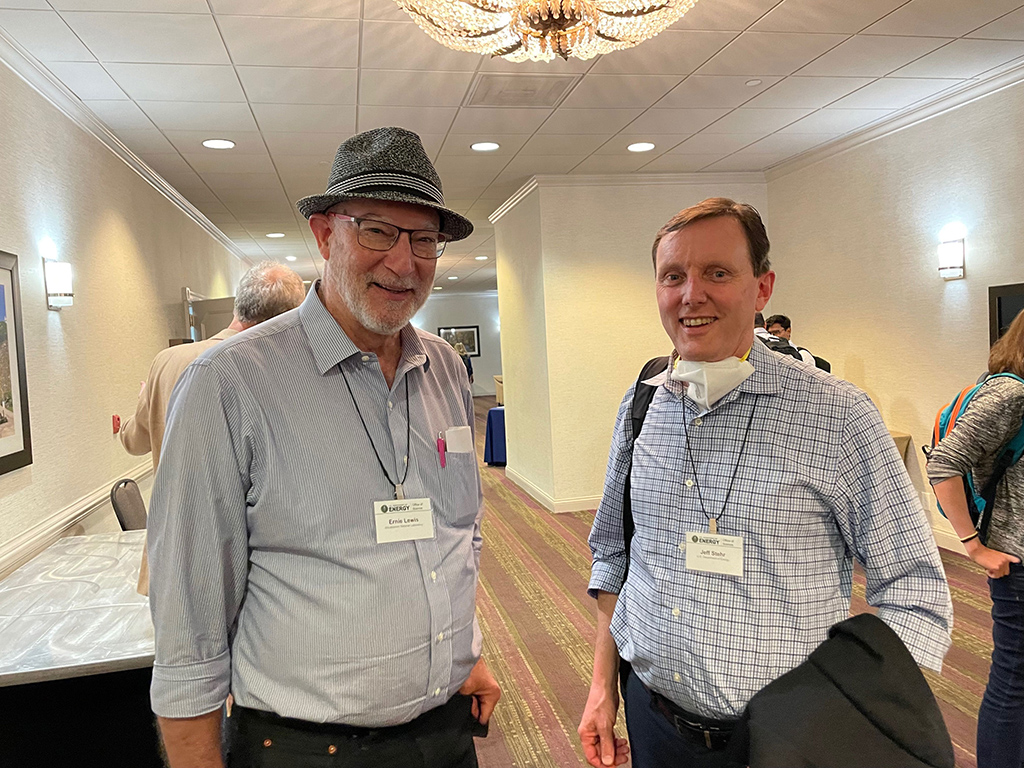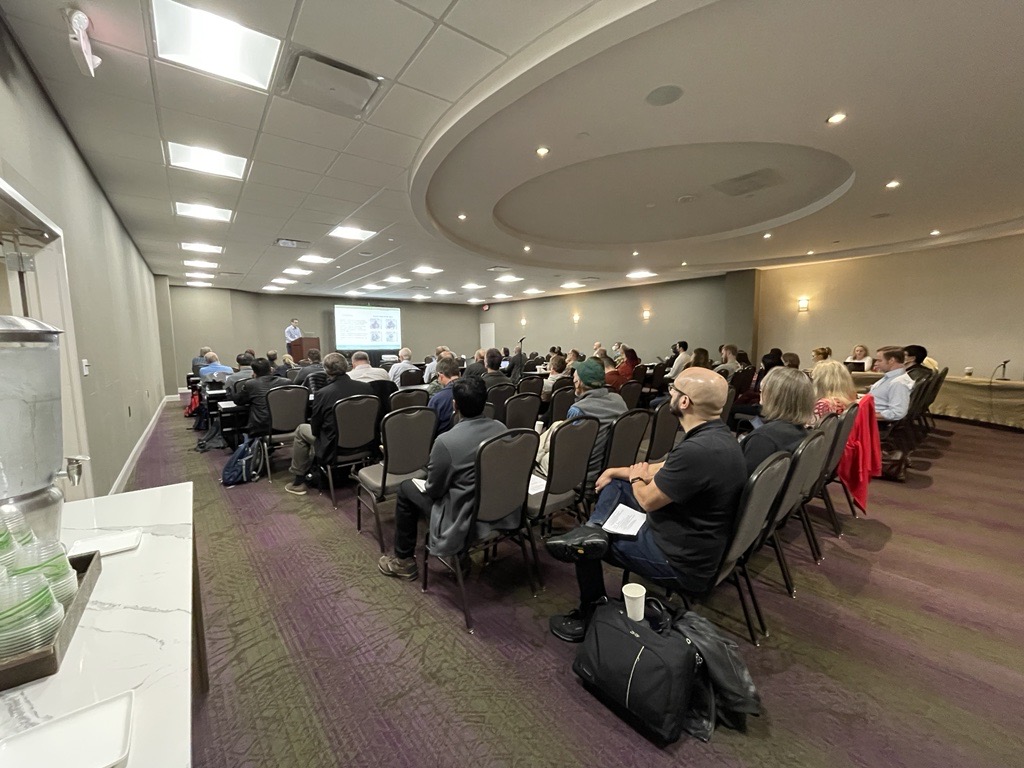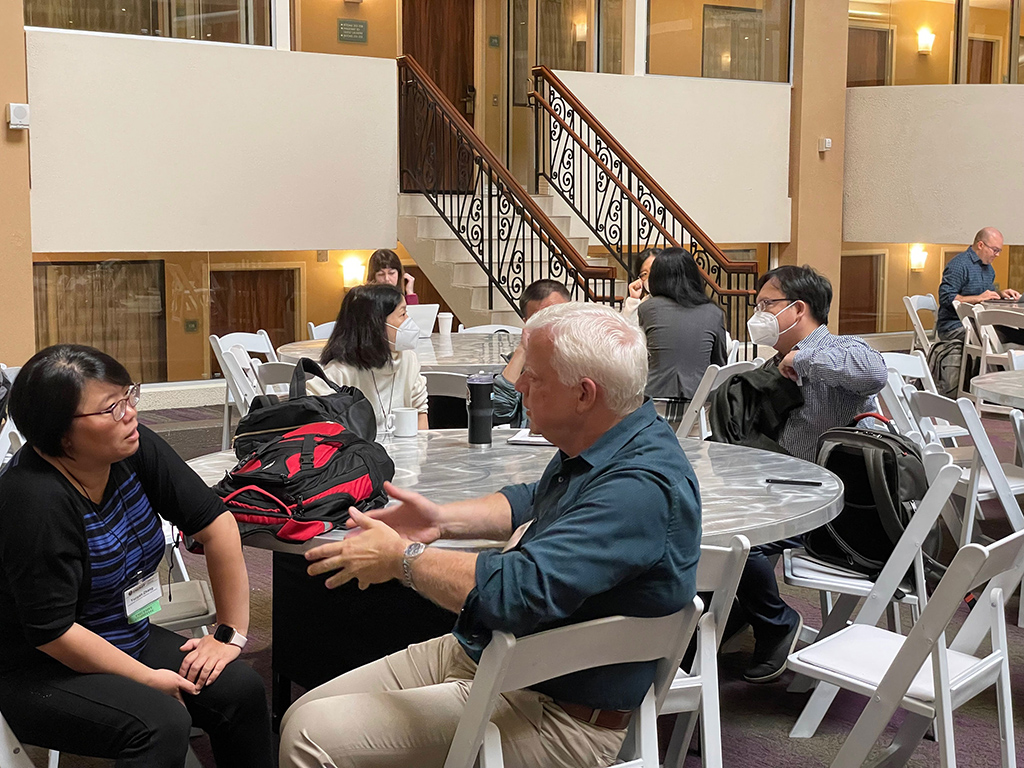
ARM users, ASR principal investigators review progress and discuss scientific priorities
The excitement was palpable as members of the Atmospheric Radiation Measurement (ARM) user facility and Atmospheric System Research (ASR) community gathered in person for the first time in three years.
The 2022 Joint ARM User Facility/ASR Principal Investigators Meeting brought together ARM infrastructure staff, ARM users, and ASR principal investigators to review progress and discuss scientific priorities for ASR and ARM.
U.S. Department of Energy (DOE) leadership also joined the festivities from October 24 to 27 at the Hilton Washington D.C./Rockville Hotel and Executive Meeting Center in Rockville, Maryland.
After fully remote joint meetings in 2020 and 2021 because of the COVID-19 pandemic, the 2022 meeting included some hybrid elements for people who needed to attend virtually. In total, 431 people attended: 280 in person and 151 virtually.
DOE ASR Program Manager Jeff Stehr, attending his first joint meeting in person, summed up the mood inside the Hilton at the beginning of his plenary talk.
“We’re here! This is awesome,” said Stehr, who started with DOE in November 2019, five months after the last ARM/ASR joint meeting in Rockville.
“There’s a lot of interest in making sure that we have better prediction capabilities that take advantage of especially the atmospheric sciences.”
— Gary Geernaert
Meeting in person allowed for collaborative working lunches and impromptu social hours as people reconnected with one another and got to know other members of the ARM/ASR community.
Virtual attendees were able to participate and present during breakout and plenary sessions, and they could also submit posters. Between virtual and in-person presenters, there were 238 posters covering facility and research updates.
Evolution of Climate Science

DOE, ARM, and ASR leadership thanked attendees for working through challenges presented by the pandemic, such as delayed field campaigns and laboratory analysis. They also acknowledged the shift to hybrid meetings, which will probably be the norm moving forward.
But even more than that is different now, said Gary Geernaert, acting Associate Director of Science for DOE’s Biological and Environmental Research (BER) program.
“The scope of what we call climate science has changed a bit,” said Geernaert.
As BER has focused more on environmental justice and urban systems, Geernaert said that the research is extending more into “engaging with people as far as climate change goes.”
In 2022, BER rolled out initiatives to provide training opportunities for historically underrepresented groups in STEM and to establish field laboratories to improve understanding of urban climate systems. DOE ASR Program Manager Shaima Nasiri and DOE Environmental System Science Program Manager Jennifer Arrigo presented on these initiatives during the October 25 morning plenary.
Urban regions are the focus of ARM’s current open call for scientists to submit preliminary proposals for ARM Mobile Facility campaigns. DOE ARM Program Manager Sally McFarlane and ARM Associate Director for Operations Nicki Hickmon reminded attendees about the call, which will close December 19.
While there was no formal budget for fiscal year 2023 at the time of the joint meeting, the outlook is “really good for BER, and, I would say, it’s especially good for this community,” said Geernaert. “There’s a lot of interest in making sure that we have better prediction capabilities that take advantage of especially the atmospheric sciences.”
Other plenary sessions provided insights into what that future might look like.
There were report-outs from four recent ARM/ASR-relevant workshops, plus science updates from 2018 DOE Early Career Research Program awardees Susannah Burrows and Naruki Hiranuma.
During their five-year DOE projects, Burrows and Hiranuma are using ARM data to study particles that seed ice formation in clouds.
Around the ARM Facility

During her plenary talk, McFarlane announced a new ARM deployment in Tasmania. Gerald “Jay” Mace, a professor of atmospheric sciences at the University of Utah, will lead the Cloud and Precipitation Experiment at Kennaook (CAPE-K) from April 2024 to September 2025.
ARM will deploy one of its three mobile facilities to the Kennaook/Cape Grim Baseline Air Pollution Station. Researchers will investigate the seasonal cycle of Southern Ocean cloud and precipitation properties and their co-variation with aerosol, dynamic, and thermodynamic factors.
In December 2022, ARM and the Environmental Molecular Sciences Laboratory (EMSL) will open their annual joint proposal call as part of the Facilities Integrating Collaborations for User Science (FICUS) program. Previous ARM/EMSL FICUS calls focused on aerosol processes and aerosol-cloud interactions. ARM will also accept proposals for tethered balloon system missions.
ARM accepts proposals for small field campaigns (i.e., cost to ARM is less than $300,000) and requests to access the facility’s high-performance computing resources at any time.
Hickmon promoted ARM’s open-science capabilities and the upcoming ARM Data Workbench, which she said would provide “seamless access to data and computing resources.”
ARM Associate Director for Research Jennifer Comstock provided updates on ARM science products, which are developed under the direction of scientists known in ARM as translators.
Comstock also announced a new ARM plan detailing translator priorities for fiscal years 2023 through 2025. Learn more about the plan.
In his plenary presentation, ARM Director Jim Mather recognized the facility’s 30 years of data. ARM collected its first data in May 1992 in Oklahoma.
Looking to ARM’s future, Mather encouraged users to provide input to the facility as it moves ahead with activities related to its Decadal Vision. He laid out ways for users to connect with ARM, such as engaging with its constituent groups. In addition, users can request new capabilities through the ARM website.
After his talk, Mather revealed the recipients of the fourth annual ARM Service Awards. See the list of winners.
Diversity, Equity, and Inclusion in Atmospheric Sciences

For the first time, the joint meeting included a plenary speaker focused on diversity, equity, and inclusion. This came at the recommendation of ARM’s User Executive Committee and others in the ARM/ASR community.
Emily Fischer, an associate professor at Colorado State University, presented on a project in which four major field campaign networks received training to recognize, report, and confront sexual harassment in field settings. Read her team’s 2021 paper on this effort.
Based on surveying participants from the field campaign networks, Fischer’s team recommends implementing bystander intervention training for sexual harassment. In this vein, ARM plans to soon set up virtual training for staff and scientists who will be in the field.
In earlier plenary talks, Stehr and Dan Stover, acting Director of DOE’s Earth and Environmental Systems Sciences Division (EESSD), noted the DOE Office of Science’s new Promoting Inclusive and Equitable Research (PIER) Plan requirement for all research proposals going forward.
Starting in fiscal year 2023, applicants must submit a PIER Plan as an appendix to their proposal narrative, describing how they will promote diversity, equity, inclusion, and accessibility in their project.
Stover encouraged attendees to view the October 17 PIER Plan webinar or contact program managers if they had questions about the new requirement.
A Deep Dive Into Campaigns

Breakout sessions at the joint meeting gave in-person and virtual attendees opportunities to key in on certain scientific and technical topics. In all, 19 breakout sessions were spread across the meeting’s first three days.
Less than a month after the TRacking Aerosol Convection interactions ExpeRiment (TRACER) wrapped up near Houston, Texas, a breakout session featured early findings from TRACER and associated campaigns.
In addition, the meeting included 32 TRACER-related posters—a number McFarlane cited during her plenary talk.
“It’s very exciting to see results coming out so soon,” she said.
The ongoing Surface Atmosphere Integrated Field Laboratory (SAIL) campaign in Colorado had its own breakout session, and so did the next ARM Mobile Facility deployment. The Eastern Pacific Cloud Aerosol Precipitation Experiment (EPCAPE) will begin in February 2023 in northern San Diego, California. EPCAPE’s session included dialogue about planned measurements and data products.
Also, the upcoming CAPE-K deployment became a discussion topic during a breakout session on cloud-aerosol-precipitation-radiation interaction studies over the Southern Ocean and Antarctic.
From the Arctic to Alabama

ARM work in the Arctic also received special attention at the joint meeting.
During breakout sessions, scientists presented research from the Multidisciplinary Drifting Observatory for the Study of Arctic Climate (MOSAiC) expedition and the Cold-Air Outbreaks in the Marine Boundary Layer Experiment (COMBLE). Both campaigns took place from 2019 to 2020.
Some ASR-funded researchers are investigating links between data from MOSAiC in the central Arctic and COMBLE in northern Norway.
In the plenaries, MOSAiC co-coordinator Matthew Shupe and COMBLE’s lead scientist, Bart Geerts, highlighted research results and what is coming from their campaigns.
Shupe said that all MOSAiC data must be publicly available by January 1, 2023. ARM has 90 MOSAiC data sets and counting. Meanwhile, a COMBLE model intercomparison project will study a cold-air outbreak event from March 13, 2020.
Arctic researcher Gijs de Boer gave a plenary presentation on the scientific impact of ARM’s mobile deployment at Oliktok Point, Alaska, which ended in 2021 after almost eight years. De Boer led ASR’s Oliktok Point site science team.
While ARM continues to collect data in Alaska at its fixed observatory in Utqiaġvik, the third ARM Mobile Facility (AMF3), which operated at Oliktok Point, will go to northern Alabama in 2023.
ARM plans to install the new five-year deployment in phases. The main AMF3 site in the Bankhead National Forest will be operational first, followed by aerial platforms and supplemental sites.
Leaders of the ARM/ASR-funded AMF3 site science team collected input from meeting attendees on the planned science drivers of the Southeastern U.S. deployment. The team is interested in processes tied to aerosols, convective clouds, and land-atmosphere interactions.
Team lead Chongai Kuang said that the group would continue to engage with the ARM/ASR community, other relevant DOE communities, and possible collaborators.
Looking Ahead

Some breakout sessions featured a distinct focus on aerosols and clouds.
In a session on advanced aerosol sampling for advancing aerosol science, participants debated the potential implementation of seasonal intensive operational periods at ARM sites. This is one of several ideas being considered by ARM’s Aerosol Measurement Science Group.
Meanwhile, ARM’s Cloud and Precipitation Measurements and Science Group asked for community feedback on current and potential science products related to boundary-layer structure, in-cloud vertical velocity, and precipitation.
Other sessions explored the use of ARM data to evaluate earth system models and how researchers could bridge gaps between observations and models.
One session updated attendees on the development of a new scenario as part of the Large-Eddy Simulation (LES) ARM Symbiotic Simulation and Observation (LASSO) activity. LASSO packages ARM observations and high-resolution simulations for various science purposes.
The LASSO team is expanding from shallow convection over ARM’s Southern Great Plains atmospheric observatory to deep convection during a past ARM field campaign in Argentina. A beta release from the deep convection scenario came out in May 2022. The full formal release will be available in early 2023.
Other sessions looked at new and emerging technologies; future directions of the ARM Aerial Facility and tethered balloon systems; and ARM radar science and operations, including a new radar plan for fiscal year 2023 and a roadmap under development to guide future activities.
All Eyes on ASR Working Groups

The final day of the meeting focused on ASR working groups, which represent ASR’s four priority research areas: Aerosol Processes, Convective Processes, High-Latitude Processes, and Warm Boundary-Layer Processes.
The day opened with working group science presentations. Each group nominated a person to give a talk representative of their research area. The four speakers were Coty Jen, Carnegie Mellon University; Adele Igel, University of California, Davis; Greg Elsaesser, Columbia University/NASA Goddard Institute for Space Studies; and Gabriel Katul, Duke University.
Each working group then broke into a two-hour session to report scientific progress and discuss needs in their research area. In addition, ARM translators gave updates on data and science products relevant to the working groups.
The meeting closed with a new fiscal year 2023 funding opportunity announcement for ASR science. DOE announced plans to provide $15 million for multiyear research projects. Pre-applications are due December 8, 2022.
Meeting Follow-Up
If you were unable to attend the joint meeting, presentation slides from the plenary and breakout sessions are published on the meeting agenda web page.
Those interested in posters can check out the full poster gallery, including abstracts.
If you have not yet submitted your presentation or breakout session summary report, please do so soon.
# # #Author: Katie Dorsey, Staff Writer, Pacific Northwest National Laboratory
This work was supported by the U.S. Department of Energy’s Office of Science, through the Biological and Environmental Research program as part of the Atmospheric System Research program.

